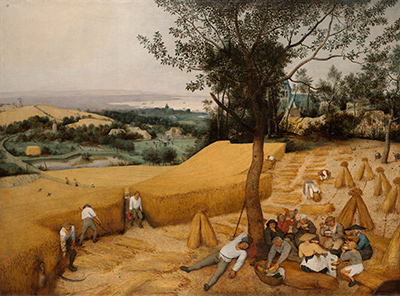The Harvesters Painting was created in 1565 as an oil on wood. It was originally part of a series of six paintings depicting the times of the year.
The work was commissioned by a wealthy Merchant in Antwerp, Niclaes Jongelinck, for his villa. Five of the six images in the series are still in existence.
In 1919 The Harvesters Painting was acquired by the Metropolitan Museum of Art and is considered to be one of their most important pieces.
The Havesters Painting depicts peasants at work on a hot day in late Summer.
The detail in this image is fascinating as are the snippets of life which Bruegel illustrates.
Overall the image portrays the closeness of man and nature. It also shows the peasants as both the producers and the consumers of the food.
This is clearly shown in the group eating under the pear tree, who are, as some experts have described, "at the root of it".
The viewer's eye is drawn down two main routes in this image. Following the women carrying the bundles of corn, the viewer is led towards the noble's castle in the distance.
En route, Bruegel has painted monks bathing in various states of dress and action. He has also depicted the village children at play.
Following the bales of corn laid out to the right, the eye is drawn to the church with the houses clustered nearby. Interestingly, on the horizon the sea appears busy with merchant ships - perhaps depicting the new and changing economics at that time.
The incredible detail within The Harvesters Painting will never cease to fascinate and amaze. A peasant climbing a tree, trespassers near the castle, a man defecating in front of a house, everywhere the viewer looks a tiny detail is revealed and another of Bruegel's witty observations of peasant life in the sixteenth century is presented.




